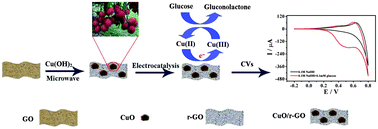Microwave synthesis of 3D rambutan-like CuO and CuO/reduced graphene oxide modified electrodes for non-enzymatic glucose detection
Abstract
A novel type of cupric oxide (CuO) particles–reduced graphene oxide (r-GO) modified electrode has been fabricated through a facile, simple and fast microwave method. Scanning electron microscopy (SEM), transmission electron microscopy (TEM), Brunauer–Emmett–Teller (BET), and X-ray diffraction (XRD) were employed to characterize the morphologies and structures of the as-prepared samples. The results reveal that the CuO/r-GO composite was a porous 3D rambutan-like microstructure with high surface area. Then the CuO and CuO/r-GO electrodes were constructed for their use as non-enzymatic glucose biosensors owing to their high-performance and sensitivity under alkaline conditions. The proposed biosensor exhibits glucose concentrations in the range from 0.50 μM to 3.75 mM. Besides, chronoamperometry demonstrates a desirable sensitivity of 52.1 μA mM−1 at an applied potential of 0.50 V (vs. Ag/AgCl), with a detection limit of 0.10 μM (signal/noise = 3). Most importantly, this non-enzymatic glucose biosensor has highly stable characteristics and can be manufactured into a long-term stability electrode for its application in various complicated circumstances. All these results confirm that this CuO/r-GO biosensor is a promising active material with excellent analytical properties for non-enzymatic glucose detection.


 Please wait while we load your content...
Please wait while we load your content...